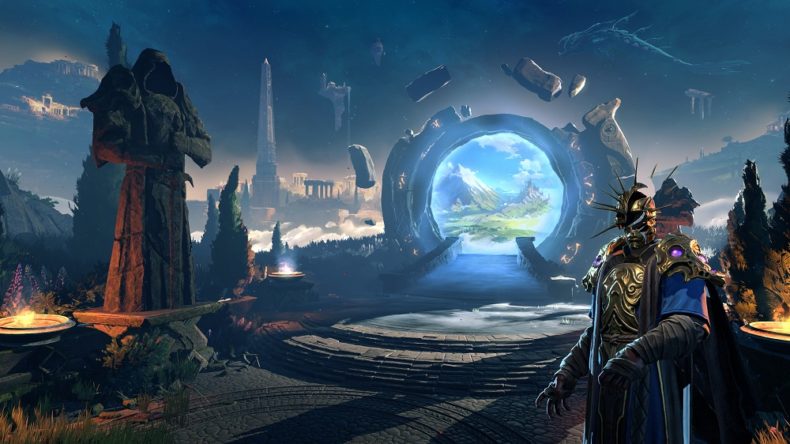The mighty Empress Elenas Ventrarr of the Dark Fey, a powerful Elfkin Wizard King who seeks out new territories in the Valley of Wonders and threatens anyone who stands in her way. She will not bow down to anyone, and any idle threat will be met with death and destruction. Regardless of the problems that arise or the violence unleashed across the realm, my Champion is cruel yet fair, fiercely loyal to those she trusts, yet merciless and vicious to those that oppose her. Age of Wonders 4 has allowed me to live out my dreams within a densely detailed and rich fantasy world, and I am more than in love with it.
I’ve been fortunate enough to have some hands-on time with Paradox Interactive’s upcoming city-building fantasy title, and from everything I’ve seen so far, players are going to thoroughly enjoy what the developers have in store in the latest instalment. Age of Wonders 4 provides a complex palette of options and customisation for you to get lost in, as well as countless decisions to make and battles to take part in. Do you look to grow your city through diplomacy and discovery, or do you tear down the free cities and destroy anyone who stands in your way?
On my first playthrough, I stuck with a pre-made faction so that I could get to grips with the fundamentals of Age of Wonders 4’s gameplay. I enjoyed what I got to see, but something was missing, and it was a sense of personality and uniqueness. After a few hours of seeing what it had to offer, I began a new playthrough with a created faction, and the outcomes of my choices couldn’t have been more different. There are different realms you can live in. Some are pre-made, or you are free to design your own with their own traits, allowing you to have a hand in the types of enemies on offer, as well as the resources and structures you might find there.
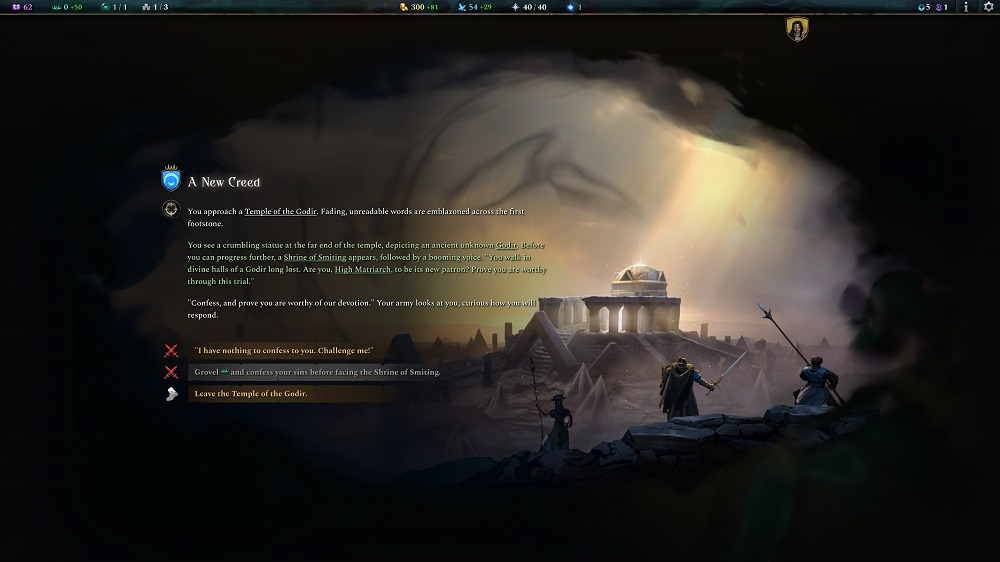
It was the Create Faction suite of customisation where I got lost in, and if you’re going to jump in to Age of Wonders 4 (which I highly recommend upon release), sifting through every detail is going to make your playthrough far more exciting. Picking from one of the ten races will start you off with the type of inhabitants of your city, each with their own traits that fall under two categories: Body and Mind. The Orcoid’s ‘Strong’ body trait outputs 10% more damage in melee and physical attacks, and their ‘Ferocious’ mind trait will offer +40% damage in retaliation and opportunity attacks. The Feline’s negative effects last a turn less, and they can build farms on sand terrain, with movement across the dunes costing two less Move Points.
These traits, however, aren’t locked in to specific races, which makes it more interesting when laying down the foundations of what your civilisation will be built around. If you want your Humans or Molekin to be tough like the Orcoids, or prefer them to focus on the Arcane like the Elfkin, that option is there. You are free to choose whatever you want by switching any of the body and mind traits around, and that’s what I did when selecting mine. I stuck with Arcane Focus which grants 15% extra damage on magic attacks for my Elfkin, yet I chose some awesome Nightmare Mounts as a body trait, as it granted 10% more HP and a chance for adjacent enemies in battle to lose 5% of their morale.
The Culture of your people will decide where their focus lies in who they inherently are. Are they going to be barbarians or industrious? Will they be made up of Feudal Lords, ladies and knights, or are they going to be a highly developed society? I wanted my race to absorb myself in darkness, and the traits of the ‘Dark’ race sounded far more appealing to me, as I could create some unique city structures and gain knowledge and income from prisons and crypts. A picture started to form in my head of how I was going to tackle my playthrough, and the more I explored the faction creation system, the more I wanted to desperately get out there and begin my journey.
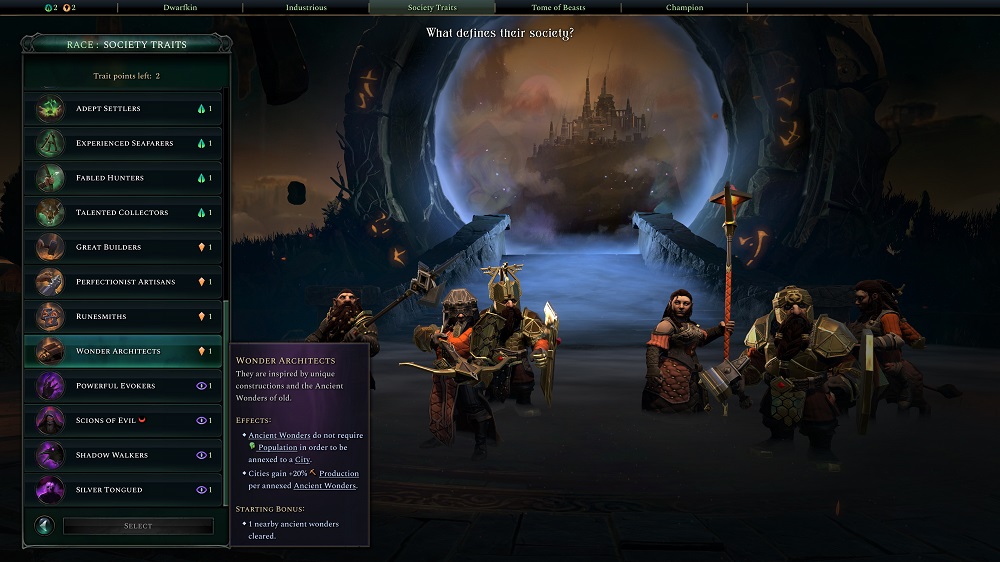
Societal Traits allowed me to be more specific about my faction’s gifts when out in the field, or how my city could thrive in interesting ways. Your people can be anything from great builders to experienced seafarers, but I chose to build on my focus on magic by allowing them to channel mana and build specific army units with a focus on arcane. It gave me a unique unit called the Evoker, who harnesses raw power, and my battle mages and support classes had an extra rank, along with five extra combat casting points. There were also some starting bonuses that sounded tasty, so it was a no-brainer for me to focus on what I did.
Age of Wonders 4 gives you the option to pick from a range of Tomes where research offers to army types and spells if you so wish. The Tome of Evocation gave me access to cheap attack spells with an additional +2 astral affinity, along with a focus on powerful lightning spells. There’re a lot to experiment with, and you’ll gain access to more Tomes as you play, such as Cryomancy, Pyromancy, and Enchantment. By this point, I had fully customised the type of faction I wanted to play through as, and the only option left was to pick who my ruler was going to be. Enter Empress Elenas Ventrarr.
Your ruler can be either a Champion or a Wizard King. The champion will be of the same race as the rest of your faction, and gains 10% more gold and +20 city stability, along with a starting bonus of a 100 relation with the free cities. The Wizard King on the other hand can be of a completely different race, and prefers “seeking dominion over a new realm.” Cities have 10% additional mana income, an extra five World Map Casting and Combat Casting points for every new level of you ruler, and an additional spell cast per turn in combat. You can pick their name, what they look like down to the last detail, and once done, you’ll now be ready to get stuck into your first game.
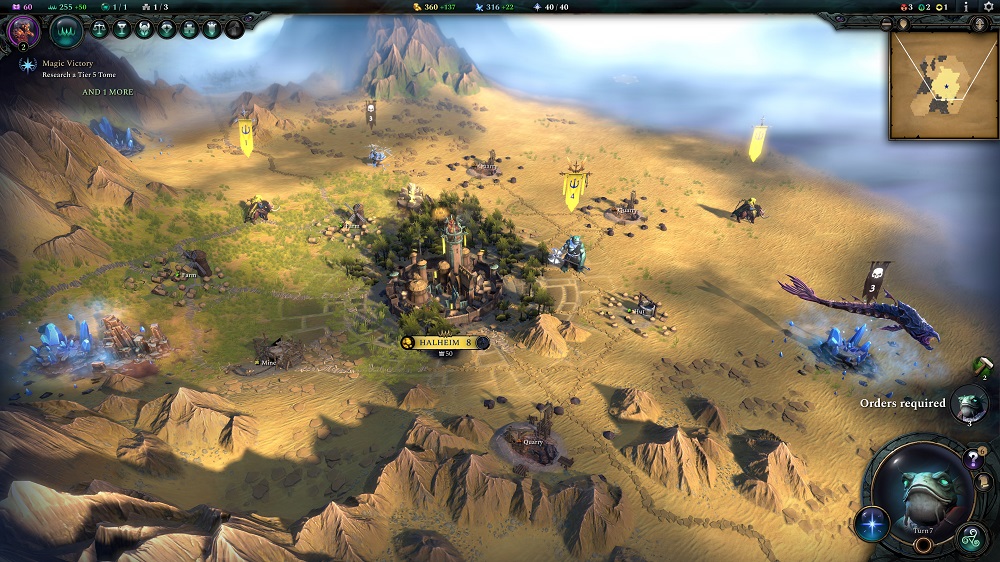
With a fully customised faction, I was now ready to start playing Age of Wonders 4. There’s a lot to take in, even before you’ve stepped foot into the realm, but details on everything you can do is highlighted clearly through an in-game encyclopaedia. You’re rarely lost for information, and by hovering over a word gives you a concise description. Depending on the type of realm you’ve stepped into, you might have objectives to complete on your way to victory, however, you can also play without any restrictions. I picked the Valley of Wonders, which constantly gave me objectives to complete and missions to finish.
The main purpose of Age of Wonders 4 is to either explore the world and expand you city, defeat rival cities and rulers by force, or process as much arcane power as possible. You’ll often find you change your approach the more you play, as new abilities, units, and structures provide different skills and opportunities. As you explore the realm, rulers from rival cities will approach you to negotiate. They might appear peaceful at first, but that can also change either depending on their true motives being revealed or how you choose to deal with them. You can offer gifts to them, negotiate a treaty of peace, or declare war and take their city for your own.
The two main resources at you disposal are gold and mana. Gold allows you to build new structures for your city and raise new units for your various armies, but it can also be used to barter with other rulers. Mana is spent to cast spells in battle as well as environmental spells that can affect neighbouring factions. You’ll naturally earn it as your city expands, but there are also pockets of gold and mana which can be farmed or found, yet there might be a monster or two guarding it, so deciding whether the reward outweighs the risk is down to you.
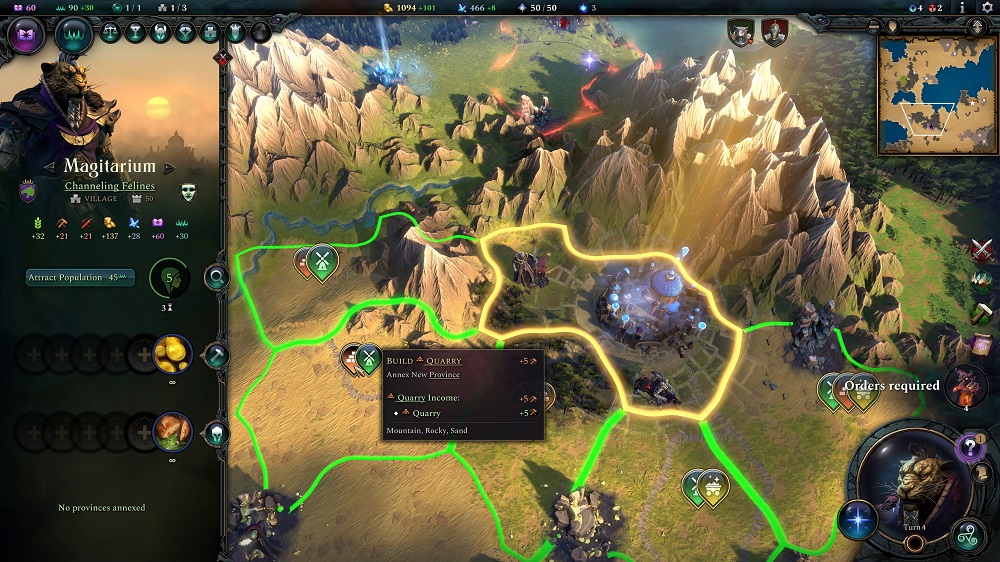
Each city produces a range of resources that all count towards your empire’s success, meaning mana and gold aren’t the only things you’ll need. Food keeps the population fed and helps it to grow; Research is what you’ll need to learn new spells from your selected Tomes; Production is what produces the new structures for your city; and having a lot of Draft will create new army factions quicker. A brand new resource to Age of Wonders 4 is Imperium, and it feeds into everything you do when building your empire. It can help boost relations with other rulers and offer new upgrades that help your empire to thrive.
Every decision you make, whether building or upgrading, moving your rulers or armies around the map, and negotiating with other rulers play out through turns. Once you’ve done what you wanted to do on a specific turn, other cities will also choose what to do. It’s exciting to see other civilisations expand and grow, especially so you can keep an eye on any threats or survey their improvements to know if they’ll become easy targets later down the line. You’ve got so many options at your disposal on each turn, and exploring the realm through your scouts or other armies can be both thrilling and dangerous.
At first, the map is clouded, but when moving you can uncover a ton of secrets, from Ancient Wonders to vicious monsters and new cities. There’ll also be story beats that pop up, giving you the option to test out your ruler’s leadership in exciting ways. Simple decisions might arise from these moments, such as choosing how a theatre production regarding your leader might end, or how you interact with a new threat. Every action has a consequence, and you’re always challenged as a leader. Sometimes you’ll flex those leadership muscles and succeed, while other times you’re left regretting your actions. Whatever happens, the sense of progression and satisfaction is never dull or arbitrary.
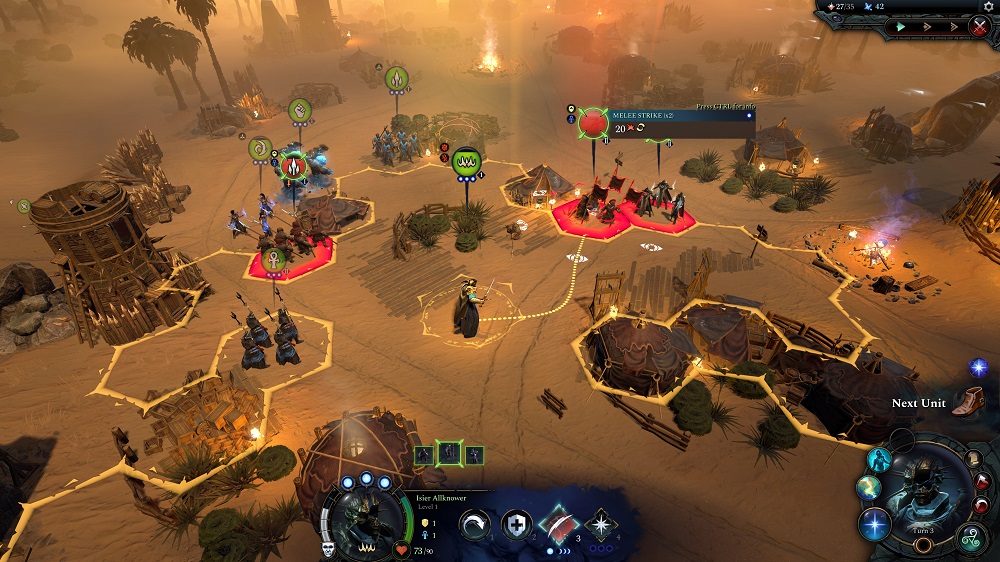
The final thing I wanted to touch upon was the combat. Whether you anticipate a battle or find yourself threatened by an attack on your city, combat never feels like a chore. Depending on how you’ve chosen to focus on your units, the wealth of options on the battlefield are vast. You don’t have to manually play through every fight, which is something I loved because sometimes the predicted victory gauge would show me defeating an enemy easily, so I’d often auto complete these fights and get back to building my empire. Other times, getting involved in the thick of battle is necessary. Each unit in your army has a number of action points, and they can be used to position your army or move forward, and attack. There’re different unit types within your army, and you’ll want to experiment with them the more you play.
Ranged units will inflict damage from afar, while melee fighters get stuck in from up close. You can send in shield units for protection, or if present, your ruler can get involved by unleashing a barrage of destruction if the right spells have been unlocked. Those decisions made when growing your city structures and the items you’ve found or unlocked across the various turns you’ve made will start to factor into battles the more you play, and customisation of warfare becomes a pleasant facet of Age of Wonders 4. Experimenting with new army types, attacks, and spells becomes standard practice, but getting that all important strategy right feels bloody fantastic. You can group up armies on the World Map, meaning battle can be epic if you so wish, as well as offering more of a chance to win.
Age of Wonders 4 is already looking like a fantastic title. The world is filled with literal wonder, and every single decision and detail can be customised to give every single player a unique experience. Depending on how your faction is built will grant you new and exciting traits that make every playthrough different, and the wealth of options in every single area makes this a must for city-building and fantasy fans alike. Expanding your city by capturing free cities and adding providences makes other rulers fear you, but unexpected threats are always emerging, keeping you on your toes and never leaving you without something to do.
Age of Wonders 4 is coming to PC and consoles in May 2023.


